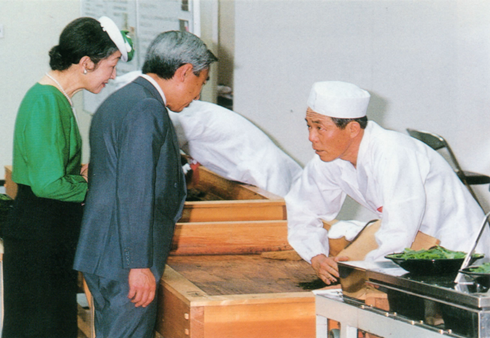
The aroma that swirls from a package of gyokuro, especially one of the highest grades, is so extraordinary that you could stop right there and be satisfied. Once brewed, the combination of spinach and seaweed, balanced by deeper flavors like butternut squash, roasted fig, and yams, somehow juggle themselves into a cup of tea, which is perfectly composed and seductively overpowering.
In 1835, Yamamoto Kahei, the sixth owner of the fabled Yamamotoyama Tea Company, traveled from Eo (now Tokyo) to Kyoto to buy and study tea. In Uji, on Kyoto’s southern outskirts, he visited a tea plantation during a frigid winter. The farmers there covered their tea plants with straw to protect them from the frost, a practice that dates to the Azuchi-Momoyama period (1568-1600). The usual winter monsoon pattern shifted during the late 1820s to the early 1840s, increasing winter’s severity and duration and forcing growers to keep the plants covered for extended periods. Europe experienced frigid temperatures in summer, resulting in the “Little Ice Age.” When the merchant tasted the resulting tea, he was astounded by the flavor; shading the tea was the key, leading to today’s gyokuro.
How gyokuro is shaded and harvested is vital since this is what makes the tea taste so good.
Shading begins when the second leaves start to sprout. Unpruned shrubs (shizen shitate), which produce the highest quality leaves, are encased in a bamboo arbor (tana-gake). The shelf arbor is covered with straw (or black synthetic fibers) suspended so that the weight does not burden the plants.
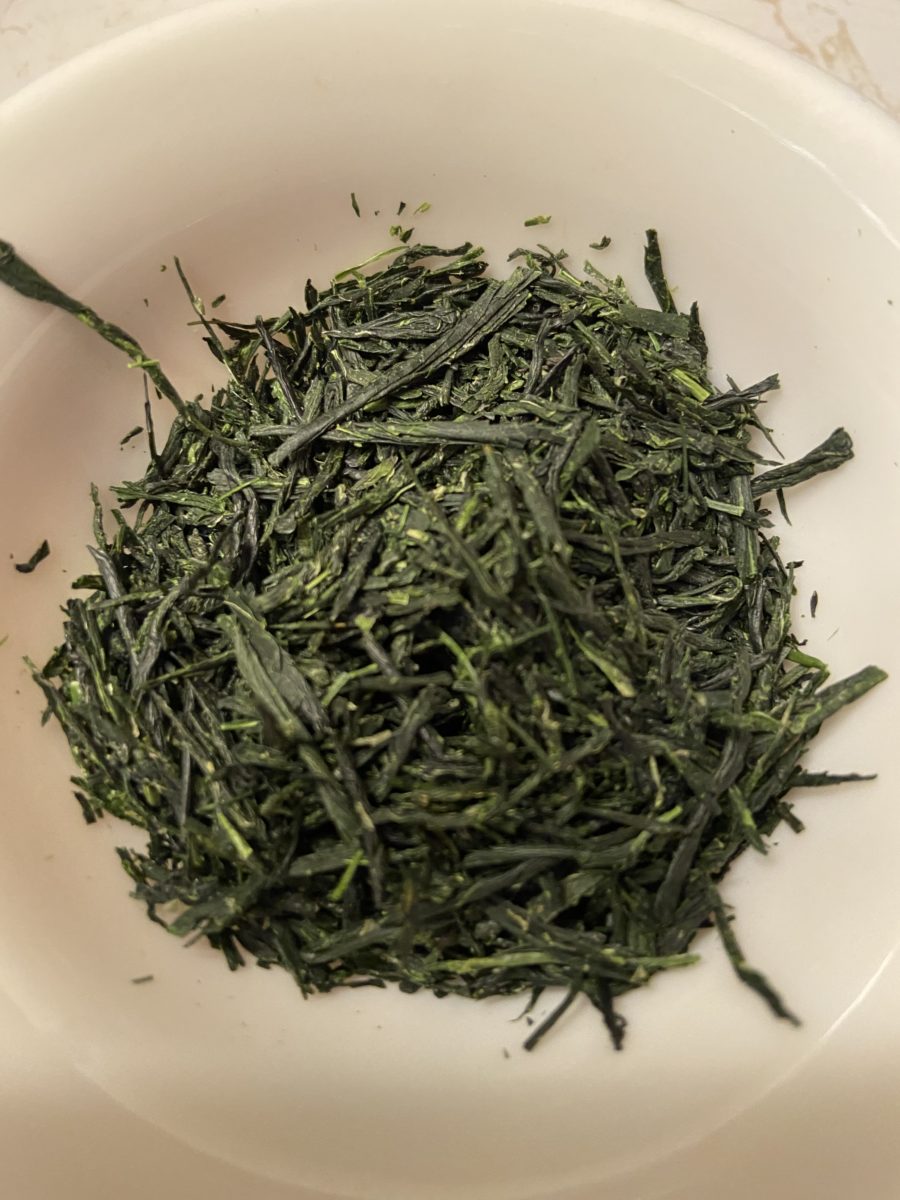
Mechanically pruned shrubs are covered with fabric. Shading filters out 85% of sunlight and lasts for ten days — additional layers of straw filter 95% of the light for another ten days. Depending on many variables, shading can last up to 30 days. This method limits photosynthesis and increases the plant’s chlorophyll production, decreasing tannin and boosting quantities of caffeine and L-theanine, an amino acid. Theanine is responsible for the sweet vegetal flavors, and umami tea drinkers notice as they sip the first infusion. Significant quantities ensure the sensation will remain through a third or fourth infusion. Theanine interacts with caffeine as a buffer that largely prevents a “caffeine” spike. Drinking gyokuro keeps tea drinkers alert and relaxed.
Gyokuros are mostly machine harvested, producing very nice teas. Unpruned shrubs are hand-harvested, the method used by the finest gyokuro producers. With hand harvesting, pluckers choose the exact leaves, generally the two topmost leaves and a bud – resulting in the best tea.
There is no shincha (fresh) gyokuro, as there is with sencha. Gyokuro must age at least five months. Many tea drinkers prefer gyokuro aged for one or two years.
In the tastings described below, the 2004 gyokuro from Uji, Kyo-Tanabe “Dejima,” from the Kyo-Midori cultivar, was aged 15 years.
When I tasted this tea in 2019, I found its unique flavor, unlike any of the gyokuros in the tasting notes that follow. To age properly, gyokuro must be kept cold and dry. Aging mellows the tea, removes its rough edges, and concentrates the flavor. Though the duration of aging differs, a young gyokuro compared to one aged for 4 or 5 years is analogous to a hugely tannic young Bordeaux wine compared to its 40-year-old future self.
Tasting Notes
Essentials include an accurate digital thermometer with a range that covers 108-140F. Japanese tea shops usually cool boiling water by pouring it from vessel to vessel and from vessel to cups; a digital thermometer makes it easy to hit the exact temperature you want.
If the tea is stored unopened tea in the fridge or freezer, let it sit at room temperature for 24 hours before opening the package to prevent the tea from absorbing any moisture when opened.
Buy a bottle of soft water. Hard water and chlorine will interfere with the taste of the tea. Here is a list of soft waters.
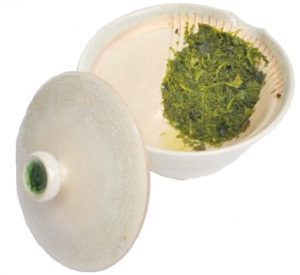
Warm your teapot and serving cups by following the Japanese tea shop practice for cooling boiling water. Water is brought to a boil and then ladeled into empty cups. Warmed cups won’t change the temperature of the tea and the amount brewed will precisely fill the teapot. Check the final temperature with the digital thermometer before pouring over the tea.
Use the shallowest teapot you can find. (A shiboridashi is ideal, but a 120 ml hohin is fine.) A shallow teapot is necessary to brew a large quantity of leaves. Add just enough water to cover. Make sure that every molecule of water interacts with the entire surface of the tea leaves. Gyokuro drinkers are obsessive about this!
Find a quiet space. If necessary, close all doors. Turn off your cell phone.
I find these measurements ideal:
10g tea
2oz. (60 ml) soft water
Temperature: 108 degrees F (42 degrees C)
Steep: 120 secondsWarm the shiboridashi or houhin teapot. Add 10 grams of gyokuro. Then slowly pour 2 ounces of water heated to 108 degrees F.
Wait 2 minutes and pour the contents into a warm teacup.Empty every last drop. Replace the lid, leaving it slightly askew so that the leaves cool.
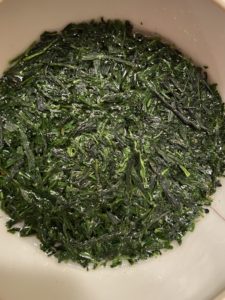
Observe the tightly rolled leaves, which resemble jade-colored needles, as they open to about half their size after the first infusion. Inhale the aroma. Take small sips. Close your eyes to concentrate fully. You will be rewarded with intoxicating scents and tastes. The 1 ½ oz or so of tea liquor produces an aftertaste that will linger for more than an hour, depending on the tea’s quality.
For a second infusion, use the same amount of water, the same temperature, and brew for only 10 seconds. Some tea companies suggest that you use higher temperature water or brew the tea for an extended period. You should experiment.
For the third and fourth infusions, use the same temperature, but steep for 20 seconds and 30 seconds. Savor each drop. Let the last flavors fade from your palate. Now you can open the doors, activate your phone, and return to everyday life.
I recently tasted five gyokuros, hand-harvested, and purchased from Maiko Tea. The teas are priced from $175/pound ($390/kilo) to $1,170/pound ($2,600/kilo).
I rate them from very good to the greatest I have ever tasted. A small quantity, about 350 grams, of the most expensive of these teas is gifted to Japan’s Emperor every year. How he brews it, how many of the infusions he drinks, what kind of water he uses, what time of day he drinks it, and whether he enjoys it alone or with the Empress- all of this remains a mystery. Gyokuro is referred to as the Emperor of tea, so it would have been interesting to know about the Emperor’s tea-drinking habits. Unfortunately, the Imperial Household Agency is tight-lipped when it comes to the Emperor’s personal life.
Yamashita Jirushi
The least expensive gyokuro is called Yamashita Jirushi. As with any gyokuro, start by sticking your nose into the bag. The aroma of the tea leaves is unmistakable. If you smell a package of sencha leaves, you will notice that the scent is one dimensional. With gyokuro, there is a multi-dimensional aroma, beginning in this tea with spinach and deepening to butternut squash, which will come out as earthy umami in the teacup. Once brewed, it starts with a light but typical gyokuro aroma. As with the tea leaves, this aroma is multi-faceted. There is a vague spinach taste. It’s not as bright as the more expensive ones, but the vegetal taste is present. The unmistakable gyokuro umami, like a yam or butternut squash, follows the initial flavor, but it is not deep umami. Overall, the tea is well balanced. It rolls around your palate, with just a hint of a buttery texture, alternating between the flavors. The second infusion is less intense but just about as good as the first brew. The third infusion is again much lighter than the second but still retains the gyokuro characteristics.
Shuppin Gyokuro
The second tea in the series is Shuppin Gyokuro. The dry leaves have a beautiful jade green color, are tightly rolled into thin needles, and have the deep vegetal and umami aroma of quality gyokuro. As we progress from one tea to the next, the aromas and the liquors deepen, with each element showing more character. In this tea, the spinach flavor is accompanied by seaweed, and the umami is more pronounced. The liquor is a bit more buttery. The second infusion is very close in flavor and umami to the first infusion. The third infusion is less intense, with all the flavors still in proportion to one another.
Nomigoro
The third gyokuro is Nomigoro. You can see and smell the difference between the previous two teas. The aroma of the dry leaves is much stronger and deeper. With this tea’s pronounced aroma of yams, you can tell that the umami will be longer-lasting. When brewed, you notice that the length of time the flavor stays in your mouth is getting longer. The spinach flavor is right out front, with the seaweed flavor coming up right behind it. A tiny sip yields rich and complex umami that doesn’t fade. It’s buttery, creamy, sweet, and savory, like the water left over after boiling spinach. A tea like this leaves an aftertaste lasting at least an hour. A second infusion is very similar and much stronger than the previous second infusions. It is lighter but perfectly balanced between vegetal and umami. The third infusion is lighter than the second one but is also perfectly balanced. Unlike sencha, which fades by the third infusion and leaves you searching for the flavors, this infusion produces a lighter version of the first infusion and a very enjoyable cup of tea.
Takumi
The fourth tea is Takumi. I tasted their next-to-best gyokuro. The first thing you notice is that your nose stays fixed to the package of tea for a long time. The tea presents levels of aroma that seem to swirl, one around the another. Instead of producing a vegetal scent followed by the scent of umami, the two scents bounce back and forth, making it hard to pull away and brew the first infusion. Once brewed, the flavor is like the darkest, greenest spinach that you can imagine, followed by freshly picked peas and ending with butternut squash. The umami is potent at first and continues to deepen even after you swallow the first sip. The liquor is slightly viscous, like the water that is left behind after rice is cooked. Each subsequent sip is as strong — the flavor lingers for more than an hour. You will want to forgo any other food or drink until it fades away. The second infusion is only slightly lighter than the first, with all of the deep spinach and umami flavors retaining their strength in relation to each other. The third infusion is much more delicate, with the vegetal flavor more in the background. As with all excellent gyokuros, the flavors remain assertive enough to produce a very satisfying cup of tea. This gyokuro produces a delicious fourth brew, at the same temperature with a 30-second steep — less intense than the previous one, but still a delightful cup of tea.[a]
Yashiki
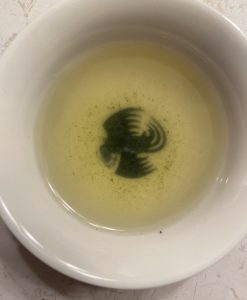
The final tea, called Yashiki no cha, earns every superlative. The leaves are overwhelmingly fragrant with deep aromas of spinach, seaweed, and peas. They smell earthy, like a forest floor. The tea is monumental; it never lets go. Brew this tea with the top removed, so you can see the leaves unfurl and inhale the unfolding aromas. After two minutes, pour the tea into your cup. It is barely green, but when you first inhale, you are immediately knocked off your feet. The first sip is so strong, so buttery, and so deeply flavored that you aren’t quite sure what you are tasting. Behind the rich green spinach and seaweed flavor is something like a bass note of unending umami, redolent of squash and yams. It’s like the drone in the background of Indian ragas. With every moment the tea is in your mouth, the flavors and sensations deepen. Sip this tea slowly and in small quantities because each sip contains an explosion of flavors. The flavors linger for hours. The second infusion is almost identical to the first. During the third infusion, the deep green flavor is still there, the bass note is less intense, and the taste is like a symphony in its complexity. The fourth infusion, brewed for 20 seconds at the same temperature, is a perfect cup of tea with lighter vegetal and umami flavors.
Tasting these different grades of gyokuro in succession was a novel experience. During the process, my ability to detect subtle nuances in flavors and aromas improved dramatically. I recommend this process to any gyokuro lover as a way to increase your appreciation of this famed tea.
Learn more about gyokuro, from harvesting to tasting at www.JapaneseTeaSommelier.wordpress.com and www.Maiko.ne.jp
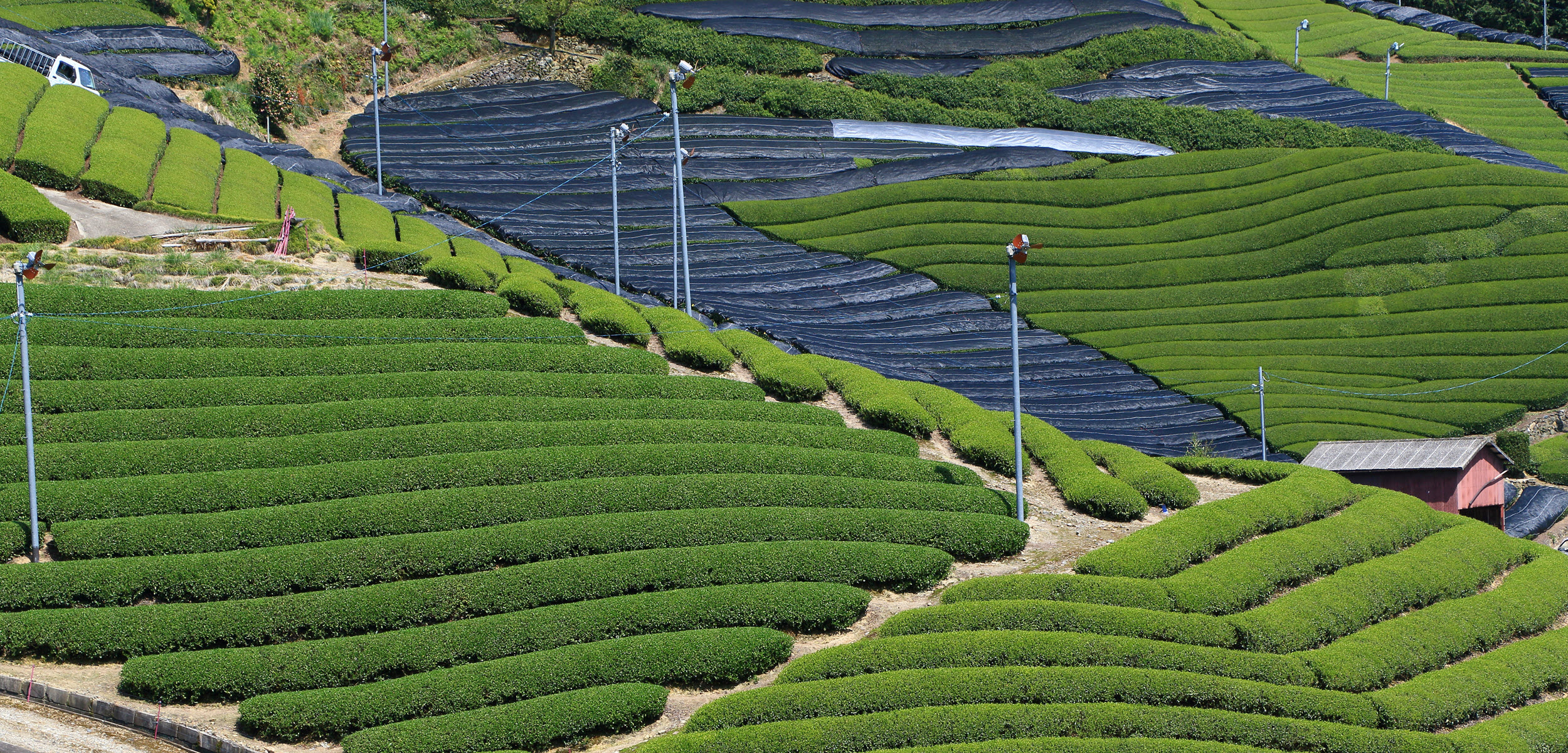
Thank you, it was both insightful and an enjoyable read.
Hi Aravinda.
Thank you.
Great article, I had no idea so much went into it.
Hi Anna.
Thanks. Try some. It’s so good!!!